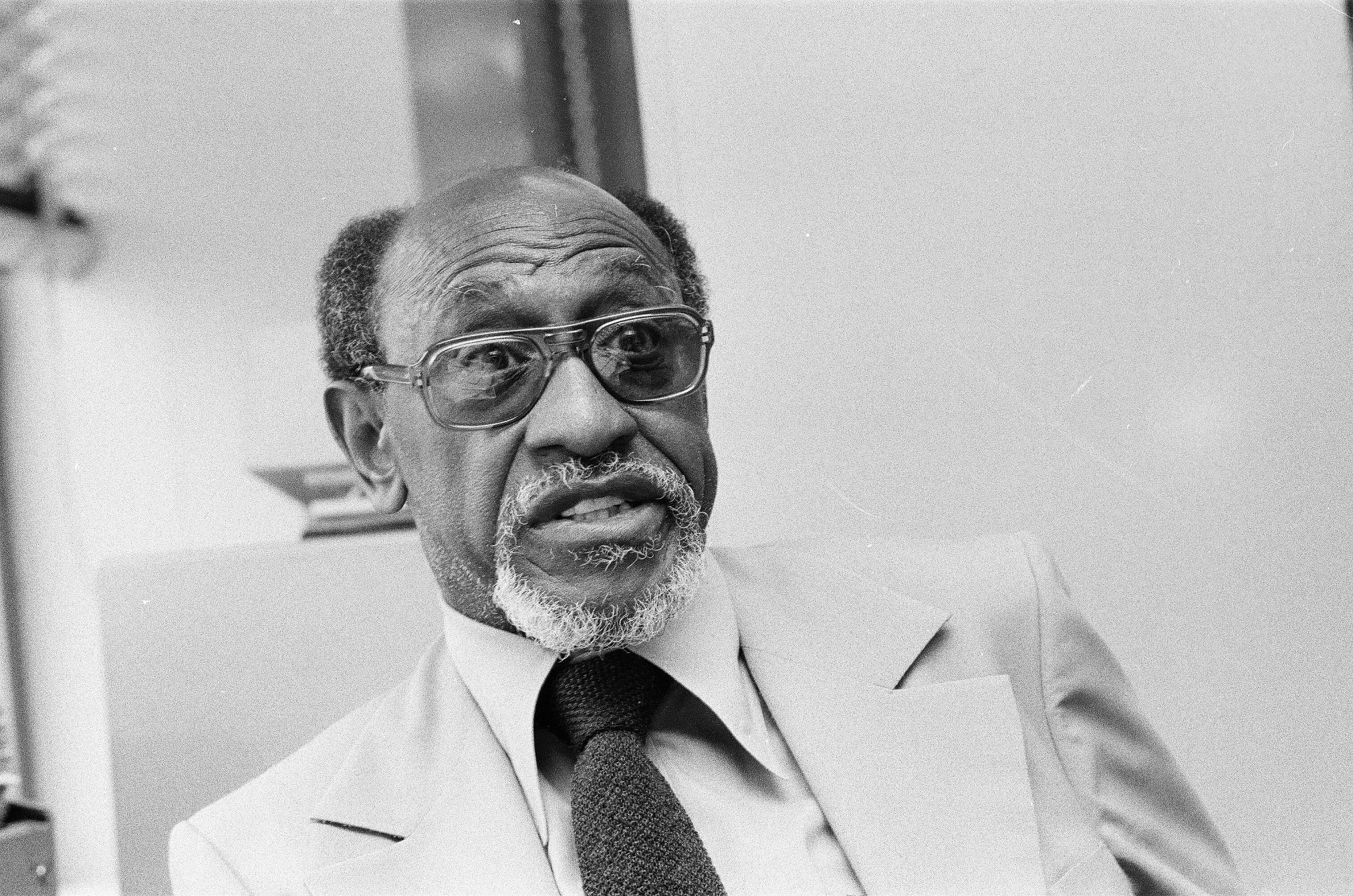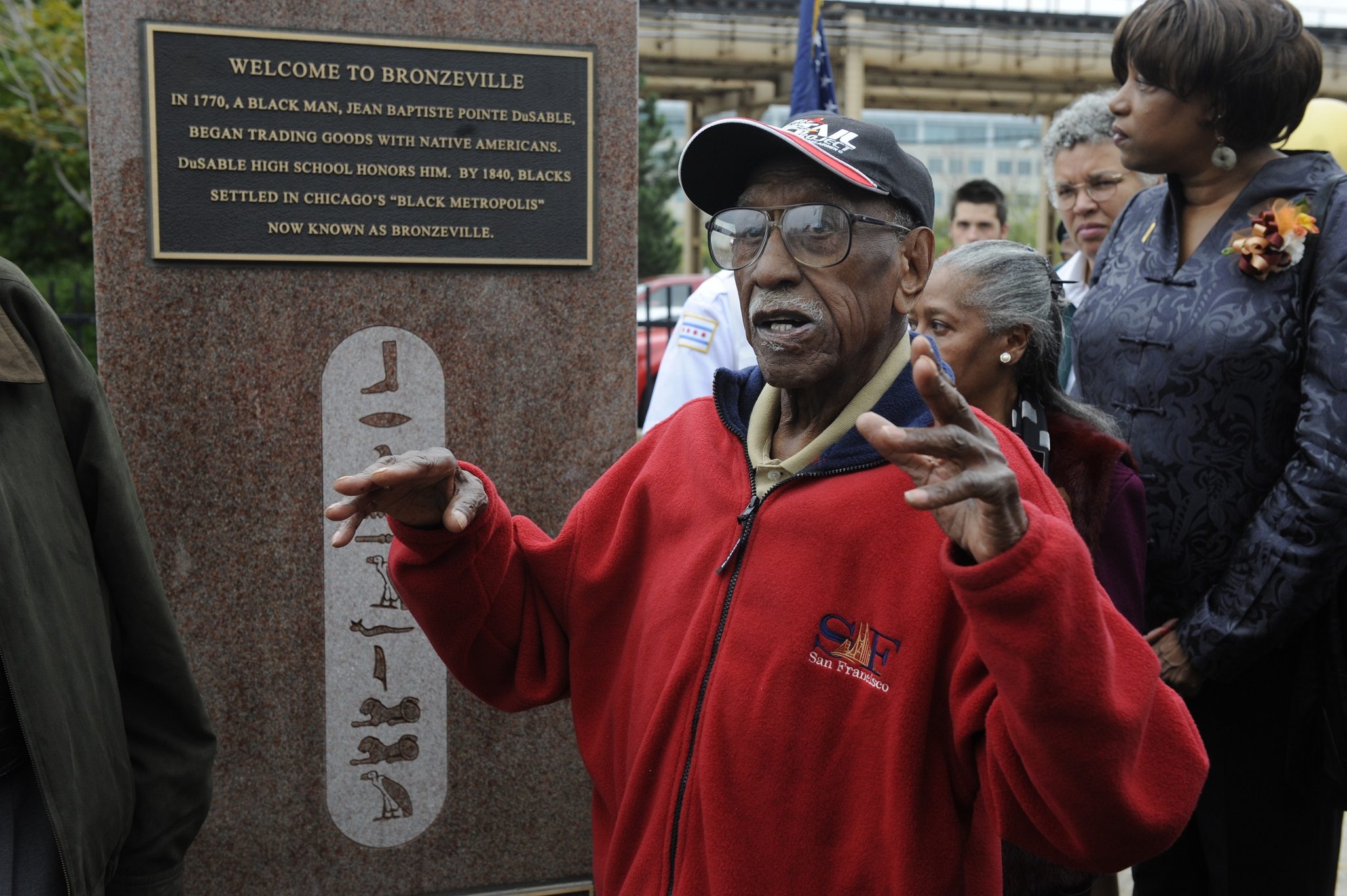Last week, noted Chicago historian, teacher, mentor, author, and civil rights leader Timuel Black died at the age of 102. Here, Warren Chapman, the second vice chair of the Chicago Historical Society’s board of trustees, and John Russick, CHM senior vice president, reflect on Black’s life as well as his work and impact on the Chicago History Museum.
“I never set out to make history, I just wanted to make things better for the people in the community.”
Warren Chapman recalls Timuel Black making that statement during an impromptu conversation in 2018. Whether intentional or not, Tim’s life became interwoven with history during the past 102 years.

Timuel Black, Chicago, July 13, 1978. ST-70000678, Chicago Sun-Times collection, CHM
He was born in Birmingham, Alabama, on December 7, 1918—right after World War I, in the middle of the influenza pandemic, and on a date that would later become synonymous with the Japanese attack on Pearl Harbor. His family moved to Chicago in the summer of 1919, which would be remembered as the “Red Summer” for the number of racial riots that occurred across the United States, including in Chicago. This period was part of a larger movement called “The Great Migration.” During this time in the early to mid-twentieth century, African American families and individuals moved to northern cities like Chicago in order to escape the oppressive, restrictive environment that existed in the Jim Crow South. Later in life, Tim was able to capture the valuable experiences and skills these people brought with them, including their hopes and dreams for themselves, their children, and those who followed in future generations.
Through his writings and storytelling, Tim was able to bring to life the faces, voices, and melodies of the people he met, grew up, and worked with over the years. As Chapman recalls: “I remember Tim commenting on several occasions that he wanted to ‘share those voices with the world and in particular with our children and future generations, so they will be able to hear what I learned and know what once was known not only to me but the entire community as well.’”

Timuel Black (right) and Zenobia Johnson-Black (second from right) with two representatives from Edwards Dual Language & Fine and Performing Arts IB School accepting the Timuel Black Teacher of Excellence Award at the Chicago Metro History Day’s (formerly Chicago Metro History Fair) SPARK Awards ceremony at the Chicago History Museum, May 21, 2019. Photograph by CHM staff
A recipient of the Museum’s prestigious John Hope Franklin Making History Award for Distinction in Historical Scholarship (2006) and the namesake of the Timuel Black Teacher of Excellence Award, Tim helped guide the Museum, beginning in the 1980s, as it sought to build its collection to share the stories of a wider range of communities and people. One personal contribution was a donation of select papers to the Museum that pertain to the civil rights movement in education.
In the fall of 1998, staff of the Chicago History Museum arrived at the Black home to photograph Tim in his library for an exhibition about older Chicagoans still working and contributing to the city. The project was inspired by the work of David Isay and featured four other remarkable Chicagoans, including Carlos Cortez, Harue Ozaki, Florence Scala, and Art Shay. The portrait of Tim was staged and shot by Shay, who served as both a subject of the exhibition and the photographer. Tim turned 80 just a few weeks later. He was a perfect fit for the project, an older Chicagoan who made history many times over and was still at it.

Timuel Black talks about the history of Bronzeville during the unveiling of two bronze obelisks at 35th and State Streets by the Bronzeville Merchants Association, Chicago, September 24, 2009. John H. White/Chicago Sun-Times © 2009 Sun-Times Media, LLC. All rights reserved.
Moreover, this effort was in large part inspired by his work to include marginalized voices in the historical narrative. His books, Bridges of Memory: Chicago’s First Wave of Black Migration (2005) and Sacred Ground: The Chicago Streets of Timuel Black (2019), provided new and profound perspectives on the Black experience in Chicago, and the Museum wanted to work with him to open a new era of historical documentation. Tim helped the Museum as both a community collaborator and a scholar in our first collection of projects designed to share the histories of Chicago neighborhoods called Neighborhoods, Keepers of Culture (2004). Tim worked to make sure the Museum connected with the people who he felt best understood the history from a local perspective. He also convinced many of them to share their knowledge and their collections of photographs, documents, and artifacts with us. Needless to say, the Museum could not have done this important work in expanding the viewpoints contained in our collection without him.
In 2018, the Museum acquired the Chicago Sun-Times photography archive and began developing a book to feature the collection. Tim, a veteran himself, graciously agreed to let the Museum include an excerpt from his book, Sacred Ground, to accompany images of returning Black soldiers after serving in combat during World War II. The profound story of a veteran, returning to a country seemingly committed to denying him equal status, simmers with relevance in our times. Such is Tim’s greatest gift to us. His work and the memories he shared are valuable not just in our time, but will grow in significance as the Museum continues with the challenging work of writing a better and more inclusive story of our city and our country.
Tim passed away on October 13, 2021, at age 102. He remained an advocate for including the experiences of all people in our historical narratives, specifically the Black experience, throughout his life. As Charles E. Bethea, the Museum’s Andrew W. Mellon Director of Collections and Curatorial Affairs, said when he heard the news, future historians will mention Tim’s name in the same breath with visionaries such as W.E.B. Du Bois and Carter G. Woodson.